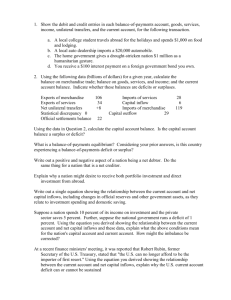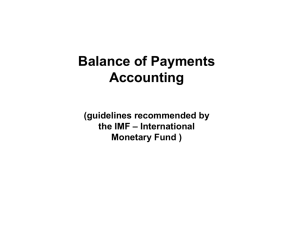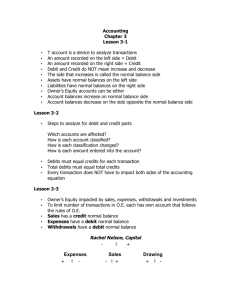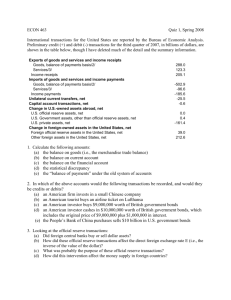Help with BOP
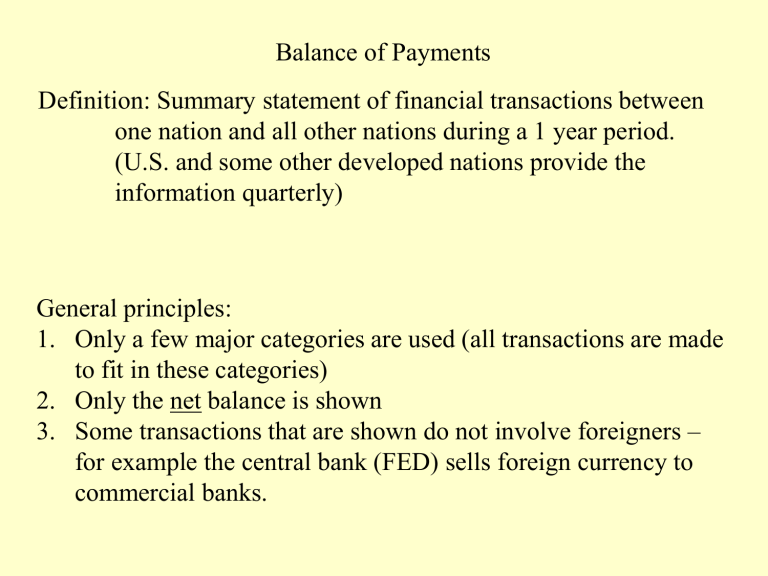
Balance of Payments
Definition: Summary statement of financial transactions between one nation and all other nations during a 1 year period.
(U.S. and some other developed nations provide the information quarterly)
General principles:
1. Only a few major categories are used (all transactions are made to fit in these categories)
2. Only the net balance is shown
3. Some transactions that are shown do not involve foreigners – for example the central bank (FED) sells foreign currency to commercial banks.
BOP (continued)
Definitions:
•
International Transaction: exchange of good, service, or asset for which payment is usually required (gifts and other transfers are also included in this definition).
• Residents include:
1. Diplomats, military, tourists and temporary workers
2. A corporation is a resident of the country within which it is incorporated.
• Foreign branches and subsidiaries of corporations are not considered residents.
BOP (continued
BOP Accounting Principles:
• Credit Transactions: transactions that involve the receipt of payments from foreigners [+ sign]
Examples:
1. Export of goods and services.
2. Unilateral transfers received from foreigners.
3. Capital inflows.
•
An increase in foreign assets in the nation
•
A reduction in a nations assets held abroad
BOP (continued
Debit Transactions: Transactions that involve the making of payments to foreigners. [- sign]
Debit Examples:
1. The importation of goods and services.
2. Unilateral transfers to foreigners.
3. Capital outflows
• An increase in a nations assets abroad.
•
A reduction of foreign assets in the nation.
Troublesome Concepts
Capital inflows
• An increase in foreign assets in the nation
• A reduction in a nation’s assets held abroad
Capital outflows
• An increase in a nation’s assets abroad.
• A reduction of foreign assets in the nation.
Balance of Payments (examples)
Action: The U.S. exports $500 or merchandise to be paid for in 3 months.
Name of Account Credit (+) Debit (-)
Goods Exports
Capital Outflow
+ 500
-500
Balance of Payments (examples)
Action: U.S. resident visits London and spends $200 on hotels, meals, etc.
Name of Account Credit (+) Debit (-)
Travel Services Purchased from
Foreigners
Capital inflow +200
-200
Balance of Payments (examples)
Action: The U.S. Government gives U.S. bank balance of $100 to a developing nation (part of a U.S. aid program).
Name of Account Credit (+) Debit (-)
-100 Unilateral Transfer
Capital inflow +100
Balance of Payments (examples)
Action: a U.S. resident purchases a foreign stock for $400 and pays for it by increasing foreign bank balances in the U.S.
Name of Account Credit (+) Debit (-)
Capital outflow: an increase in
U.S. owned assets abroad
Capital inflow: an increase in foreign owned assets in the U.S.
+400
-400
Balance of Payments (examples)
Action: a foreign investor buys $300 of Treasury Bills by drawing down bank balances in the U.S.
Name of Account Credit (+) Debit (-)
Capital inflow: an increase in foreign owned assets in the U.S.
Capital Outflow: a reduction of foreign owned assets in the U.S.
+ 300
-300
Resulting BOP From the 5 Previous Transactions
Name of Account
Goods
Services
Unilateral Transfers
Capital
Credit (+)
500
Debit (-)
200
100
200
Total 500 500
Explanation of Various Balances
•Balance on Goods Trade: Just the net of imported and exported goods
•Balance on Services: Just the net balance of the services account
•Balance on Goods and Services: Net balance of the above two accounts
•Balance on Income: net balance of income from assets abroad and income payments to foreign assets held within the domestic country
•Balance on goods, services and income: Net balance of the above three accounts
Explanation of Various Balances
(continued)
•
Unilateral Current Transfers Net: Just the net of unilateral transfers
•
Balance on all the above = Current Account Balance
•
Current Account Balance = net balance of
1. Goods
2. Services
3. Income
4. Unilateral transfers
Current Account Surplus = stimulus for domestic production and income
Current Account Deficit = drain on domestic production and income
Remember (Xprts-Mports) from your macro principles class!
Capital Account:
•The net change in U.S. owned assets abroad and foreign assets in the U.S. [Excluding official reserve assets because they reflect government policy]
Autonomous Transactions: All transactions in current and capital accounts [also known as items “above the line”]
Accommodating Transactions: transactions in official reserve assets
[also known as items “below the line”]
These may be needed to balance international transactions
This is known as the
“official reserve account”—the balance of this account is know as the official settlements balance
Official Settlements Balance
Total debits > total credits [in the current and capital accounts
• The net debit balance measures the deficit in the nations
BOP: This debit must be “settled” with an equal net credit in the “official reserve account”
a deficit in the BOP is measured either as
1. An excess of debits over credits in the current and capital accounts, or
2. An excess of credits over debits in the official reserve account
Official Settlements Balance (continued)
a deficit in the BOP is measured either as
1. An excess of credits over debits in the current and capital accounts, or
2. An excess of debits over credits in the official reserve account
These explanations are strictly correct only under a fixed exchange rate system [1945-1973]. They are not strictly correct under a flexible or managed exchange rate system like we now use (but they are close).


